Design of Experiment Strategy for an Electrospray Ionization Optimization in Supercritical Fluid Chromatography–Mass Spectrometry Coupling
LCGC Europe
The optimization of adjustable factors in electrospray ionization (ESI) by design of experiments (DoE) is presented. This approach allows a comprehensive and systematic optimization of all relevant factors for the ionization of compounds and increases the understanding about factor influences on the ionization efficiency.
The optimization of adjustable factors in electrospray ionization (ESI) by design of experiments (DoE) is presented in this article. This approach allows a comprehensive and systematic optimization of all relevant factors for the ionization of compounds and increases understanding about factors that influence ionization efficiency. In total, 32 different compounds were separated by supercritical fluid chromatography (SFC), ionized, and then detected by time-of-flight mass spectrometry (TOF-MS). A three-stage optimization process was used to find a robust setting point for eight factors influencing the ionization for SFC-separated compounds. The results obtained for all eight factors were evaluated by multivariate statistics. At first, the influence of all eight factors on the ionization of compounds and applicable factor ranges was investigated in a geometric experimental design. Subsequently, a more comprehensive design was used to identify optimal factor settings to reduce factor ranges. Finally, the robustness of the derived setting point was assessed. The robust setting point obtained provided a sufficient ionization of all investigated compounds. The presented optimization approach allows a systematic optimization of several ionization-influencing factors, resulting in robust and statistically-assessed ionization for all the analytes investigated. In addition, design of experiments provides further information about factors that influence the ionization of compounds by electrospray.
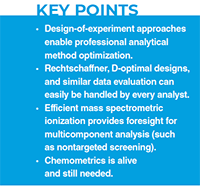
Electrospray ionization (ESI) is a well-established technique and is commonly applied in various disciplines such as metabolomics (1–3), proteomics (4,5), food analysis (6,7), and environmental analysis (8,9). ESI interfaces are used for transferring and ionizing analytes from the liquid phase into the gas phase to connect chromatographic techniques with liquid mobile phases and mass spectrometric (MS) detection. Ionization in ESI occurs under atmospheric pressure, by spraying the effluent of a chromatographic technique into an electrical field (10). Drying and sheath gas flows are used to dry the droplets and to enhance the transition of analytes to ions (11). The formation of ions can be explained by the ion evaporation (12,13) and the charged residue model (11). The efficiency of ionization directly depends the sensitivity of the subsequent MS detection and is related to physicochemical properties of the analytes as well as the mobile phase (3,14,15). An optimization of ionization parameters in ESI is therefore a necessary and critical step for method development to achieve optimal detection of analytes. Optimization strategies can strongly differ from one-parameter optimization (16) to advanced statisticsâbased approaches (17,18). When coupling chromatography with ESI-MS, mobile phase composition, compound coelution, and ion suppression as well as enhancement caused by matrix compounds need to be considered as important influences on ionization efficiency and MS detection limits (19–21). The optimization of ESI parameters should be performed with the same analytes and chromatographic method as in the analyses. Optimizing ESI parameters to allow for the simultaneous (most sensitive) detection of several compounds can be a complex challenge. One-factor-atâaâtime optimization (OFAT) approaches are time-consuming as all adjustable ESI parameters should be considered and the number of analytes or sample complexity increases. In addition, not all factors might contribute equally to the efficiency of the ESI ionization and interactions between factors cannot be determined this way. Chemometrics or design of experiments (DoE) can provide alternative but powerful approaches to investigate and optimize such complex systems as ESI (22). In DoE, all adjustable factors create a design space in which the number of dimensions is equal to the number of factors. For each factor, certain levels of variation are defined and the performed, balanced, orthogonal, and symmetrical positioned DoE experiments mark the corners of the design space. The significance of the effects resulting from changing factors can be determined by the analysis of variances (ANOVA) (23). The number of DoE experiments that have to be performed depends on the used experimental design and its resolution. A high-design resolution allows the investigation of two factor interactions, but requires more experiments than low-resolution designs (23).
In this study, an analytical supercritical fluid chromatography system (SFC) was applied in coupling time-of-flight mass spectrometry (TOFâMS) via electrospray ionization. The mobile phase in SFC separations is mainly comprised of carbon dioxide (CO2) and organic solvents, such as methanol, which are added to modify the elution strength of the mobile phase (24). The system was aimed to be used for the analysis of environmental water samples, which can easily contain several hundreds of compounds. As well as mass accuracy, high sensitivity in MS detection is required here. This can also be improved by the optimization of ESI parameters, resulting in more effective ionization.
Since exclusively ESI-specific parameters were optimized, this strategy can easily be transferred to the optimization of MS ionization for other chromatographic techniques, and can be applied without detailed knowledge about ionization mechanisms.
Experimental
Reagents: Carbon dioxide (99.995% purity) for SFC separations was obtained from Linde AG and Westfalen AG. Methanol (HiPerSolv Chromasolv liquid chromatography [LC]–MS-grade) was bought from VWR, water (LC–MS Chromasolv-grade) was purchased from Fluka and ammonium acetate from Sigma Aldrich. Standard substances were obtained from Sigma Aldrich, Fluka, Dr. Ehrenstorfer, and Cimachem. Details are listed in Table 1. Standard substances were dissolved in 50:50 methanol–water (v/v) and united to a working mixture, containing 500 µg/L of each compound.
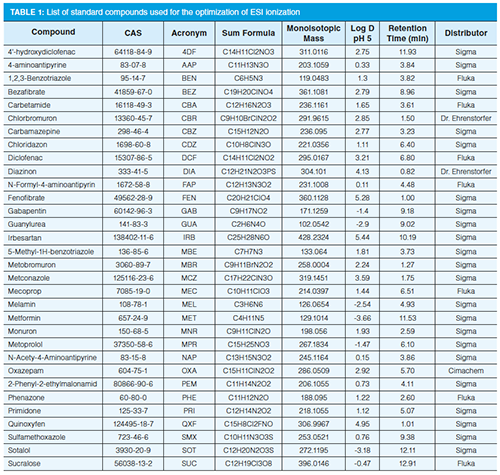
Chromatography and Mass Spectrometric Detection: The chromatographic separations of the working mixture were performed with an analytical SFC system (Agilent Technologies) using a 150 × 2.0 mm, 5-µm zwitterionic HILIC column (Knauer). The mobile phase consisted of carbon dioxide and methanol, containing 20-mM ammonium acetate. Compounds were eluted from the column using a gradient from 5% to 40% 20-mM ammonium acetate in methanol. The flow rate was 1.5 mL/min, with a constant back pressure of 150 bar. Column temperature was set to 40 °C. The sample injection volume was 5 µL. The outlet of the SFC system was directly connected to a JetStream ESI source, which was used as the ion source of a 6230 time-of-flight mass spectrometer (Agilent Technologies). The SFC separation method allowed the generic separation of all investigated compounds in the log D (pH 5) range -3.66 to +5.44 (see Table 1) and required no further optimization. Mass spectrometric data were evaluated using Agilent MassHunter Workstation Software Profinder (B.06.00).
Optimizable ESI Parameters: In order to perform a comprehensive optimization of ESI ionization, eight ESI factors were included in the experiments. These were drying gas temperature and flow rate, sheath gas temperature and flow rate, nebulizer pressure, nozzle voltage, capillary voltage, and fragmentor voltage. The adjustable factor ranges and the setting accuracies are summarized in Table 2. Factor settings of individual experiments were rounded according to the setting accuracies of the factors. All factors could be chosen freely, except for sheath gas temperature and flow rate; here the flow rate had to be increased when increasing sheath gas temperature. This constraint was considered in all experimental designs.
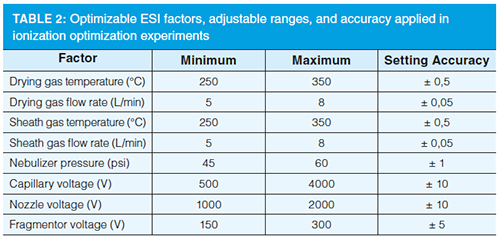
DoE Approaches: The study included eight ESI factors that had to be optimized to achieve a sufficient ionization for 32 different compounds. For all parameters, the full adjustable ranges were considered for optimization. Modde Pro (Sartorius Stedim Biotech, Version 12.1) was used for the creation of experimental plans, based on Rechtschaffner or D-optimal designs and data evaluation. Randomization of experimental order was applied to minimize the impact of external procedure influences. To ensure that all temperatures were fully equilibrated in the ESI source, a blank SFC injection was placed prior to the next injection of reference standards. The ESI parameters of the blank injection were the same as those of the following reference injection.
Results and Discussion
Compound ionization is the key element for sensitive MS detection, regardless of which chromatographic system is connected. However, the connection of SFC to MS detectors requires special attention because of mobile phase composition and its depressurization (25). ESI is the most commonly used ionization source for SFC–MS applications and several connection modes involving make-up flows and/or utilizing a flow splitter have been investigated previously (26,27). In this study, the full mobile phase stream of the SFC system was introduced into the ESI-interface and additional make-up flow was added. The make-up flow was intended to support ionization independent from the composition of the mobile phase in SFC separations (28,29). Eight factors in total were used for the ESI optimization, including drying and sheath gas temperatures and flow rates, nozzle, capillary and fragmentor voltages, and nebulizer pressure. As a result of the number of optimizable factors and potential interactions of different factors, DoE was chosen as the optimization approach. The optimization was performed using 32 compounds (Table 1), all of which are likely to be detected in samples of the aqueous environment. The optimization procedure was specifically tailored to the technical requirements and contained three stages. In a first screening, the impact of all factors was investigated in predefined adjustable ranges. The results were used to reduce the factor ranges to more relevant parameter and regions. These ranges were used in the second stage to find optimal conditions for all factors, resulting in a robust setting point within the design space. In stage three, the robustness of the obtained setting point was tested. As a minimum requirement, a signal height of 1000 counts was defined for all compounds.
Evaluation of Factor Influences and Parameter Ranges: The sensitivity of SFC–MS can be as good or even better than the sensitivity of LC–MS, but this requires a comprehensive optimization of the relevant factors in adequate ranges (30). To estimate the influences of the chosen factors and to evaluate their relevant ranges for the SFC–ESI-MS application, a Rechtschaffner experimental design was chosen. This geometric design employs response surface methodology and analyzes linear and nonlinear factor contributions. It is also very effective in terms of the low number of experiments needed in the test plan. All experiments were performed twice in randomized order, which resulted in 96 runs, including six experiments at the centre point of the experimental space. The ion chromatograms of all investigated compounds were extracted on the basis of the elemental formula, considering protonated ions, as well as sodium and ammonium adducts of each compound. Detected ions and adducts were combined by the software to features, of which the signal height was used for further evaluations.
The signal intensities of all compounds showed that the fragmentor voltage had the highest influence (78.6%) on the signal height of the detected compounds (Table 3). The fragmentor voltage can be adjusted to decluster ions in the mass spectrometer used, so a high impact on ionization efficiency would be expected. Effects on the ionization by other parameters were comparably small because overall effects were dominated by fragmentation voltage. As the fragmentor voltage is located at the transition from ionization to ion guiding, this parameter is possibly more related to ion optics than to ionization. Interactions of other factors, such as gas flow rates and temperatures, could be expected.
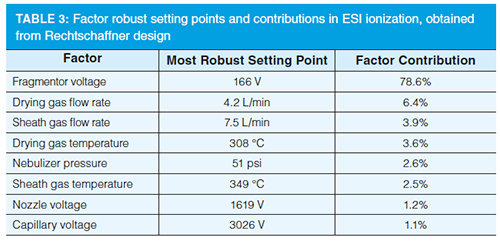
The sheath gas flow rate and temperature could exclusively be changed in certain ratios for the instument used. This additional term resulted in a limitation of the geometric investigation pattern, which had to be considered in the creation of the design space (Figure 1). Rechtschaffner designs are very suitable to investigate factors independently between minimum and maximum levels. To consider limitations such as step-wise changes of parameter values, resulting in constraint investigation spaces, it is necessary to switch from a geometric design, such as Rechtschaffner, to a mathematical D-optimal design.
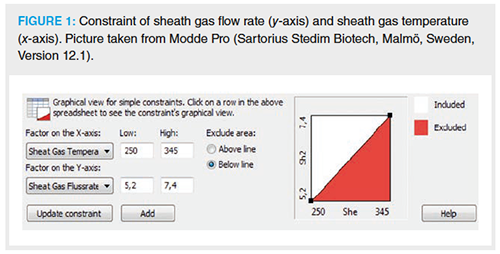
Optimization of Parameters: The D-optimal design calculates the optimal locations of the experiments within the given investigation space. For a given model, Y = Xb + e, the D-optimal approach maximizes the determinant of the matrix X’X (31). The new experiments, together with the former, span the largest volume possible in the experimental space. In summary, a D-optimal design can be tailored to support an irregular experimental region, or a very complex problem setup (31). For the D-optimal design, the fragmentor voltage-which showed the highest influence on the ionization in the previous experiments-was kept constant at 166 V, the most robust setting point for the investigations. The chosen candidate set of the D-optimal design with seven considered factors resulted in 47 runs. Twentyânine of the 32 analyzed standard compounds were detectable within all investigated factor combinations. Chlorbromuron, fenofibrate, and sulfamethoxazole, not consistently detectable in this study, were excluded from the evaluation. The most robust setting point and individual factor contributions for the minimum signal height requirement of 1000 counts for all compounds are summarized in Table 4. Nearly all factors showed comparable contributions to the ionization efficiency, only the sheath gas temperature showed a minor impact. The most robust setting point values of the factors, however, were not comparable to those obtained from the Rechtschaffner design. GrandâGuillaume Perrenoud and coworkers investigated the coupling of SFC to ESI-MS with integrated flow splitting with six optimizable factors and found the capillary voltage, desolvation temperature, and the drying gas flow rate as the three most impactful factors (26). Although the ESI and MS models and vendors were not the same as in this study, the results are comparable. The predicted signal heights at the robust set point were compared to measured signal heights (Table 5). Although the predicted and measured signal heights did not always match (Figure 2), this setting point guaranteed a sufficient detection of all considered compounds, with more than 1000 counts for each analyte.
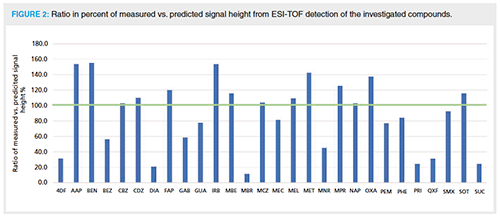
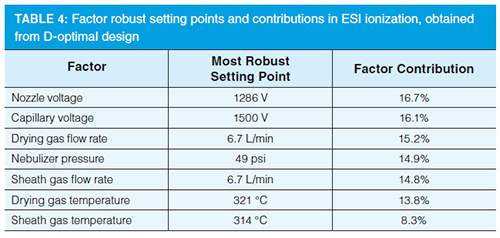
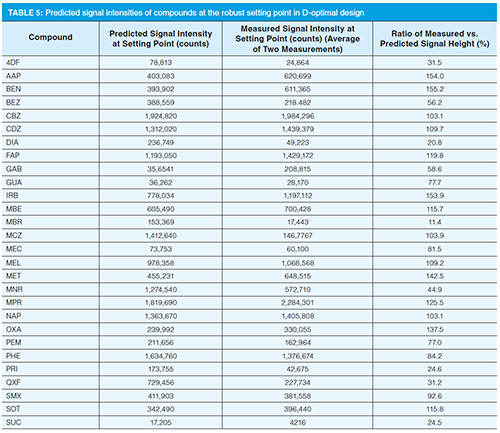
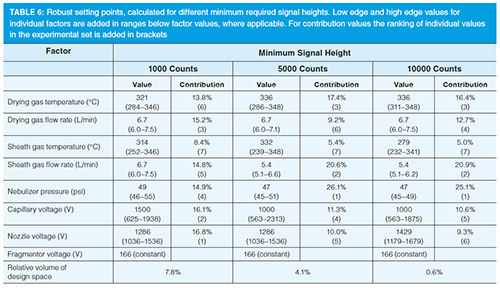
Robustness of the Optimized Factors: To assess the robustness of the results provided by the D-optimal experimental design and to test the quality of the signal height prediction, the borders of the sevenâdimensional design space were tested for compliance with the preâset specifications. Therefore, results from the optimization were used and evaluated in a linear design by adjusting the minimum requirement for the signal height. The calculations, made using 1000, 5000, and 10,000 counts, resulted in different robust setting points for the optimized ionization method (Table 6). The acceptable minimum and maximum values for each factor were calculated using Monte Carlo simulations, leading to the determination of Manhattan distances (32). The altered minimum requirement for the signal height also led to a decrease of the available design space. While the requirement of 1000 counts could be reached in 7.8% of the tested design space volume, this space was decreased to 0.6% when increasing the requirement to 10,000 counts (Table 6). This is also true for the ranges in which factors could be changed without the risk of reaching signal heights below the pre-defined value. With the increasing signal height requirement, the ranges of most factors decreased. This can be observed at the drying gas temperature, which can be set between 284 and 346 °C (range of 62 °C) to reach 1000 counts as minimum signal height, and between 311 and 348 °C (37 °C difference) for a minimum of 10,000 counts. The contribution of the investigated factors changed with changing the minimum requirement. While nozzle voltage and capillary voltage showed the highest impact on the observed signal for the 1000 counts minimum requirement, the highest impact was observed for nebulizer pressure and sheath gas flow rate when increasing the minimum signal height to 10,000 counts. This can be explained by reduced factor ranges and shifting set point locations. Interestingly, all values of the robust set point for 1000 counts-except for the sheath gas flow rate-are in the ranges of the according values for the 10,000 counts requirement. This also reflects the increasing impact of the sheath gas flow rate with increasing signal height requirements.
Conclusions
The optimization of the electrospray ionization procedure was conducted in three stages. The first rather simple experimental design offered an overview on relevant factors and identified reasonable factor ranges. The results gained were used in a more complex design, which resulted in a robust set point at which a pre-set signal height could be achieved. As a last step, the robustness of the final optimized ionization method was assessed. This resulted in factor ranges in which a sufficient ionization for all considered analytes should be achievable. This approach allows a systematic optimization of all ionizationâinfluencing factors and offers a robust and statistically assessed ionization for all considered analytes. In contrast to other “trial and error” optimization approaches, the quality by design (QbD) approach allows a comprehensive, systematic, and a less laborious optimization.
In practice, this approach is very useful to several analysts because, subsequent to a detailed and consequent optimization, the results may remain robust and sensitive for a long time (not only in ionization optimization). This approach can be used for a variety of ESI systems and several types of mass spectrometer (coupled with different chromatographic techniques).
To conclude, a smart DoE approach seems to be time-consuming, however, in the long term it saves a lot of time compared to an OFAT approach.
Acknowledgements
The authors would like to thank Jörg E. Drewes and Sylvia Grosse for their support. Thank you to Agilent Technologies for the analytical SFC system as a loan and Knauer for the column used in SFC separations, as a gift. TL acknowledges the financial support from the German Federal Ministry of Education and Research in funding FORIDENT (02WRS1456A).
References
- Z. Lei, D.V. Huhman, and L.W. Sumner, J. Biol. Chem.286(29), 25435–25442 (2011). doi:10.1074/jbc.R111.238691
- A. Kamleh, M.P. Barrett, D. Wildridge, R.J.S Burchmore, R.A. Scheltema, and D.G. Watson, Rapid Commun. Mass Spectrom.22(12), 1912–1918 (2008). doi:10.1002/rcm.3564
- P. Kebarle and U.H. Verkerk, Mass Spectrom. Rev.28(6), 898–917 (2009). doi:10.1002/mas.20247
- I. Lancrajan, R. Schneider-Stock, E. Naschberger, V.S. Schellerer, M. Stürzl, and R. Enz, J. Cell Mol. Med.19(7), 1656–1671 (2015). doi:10.1111/jcmm.12540
- A.A.M. Heemskerk, A.M. Deelder, and O.A. Mayboroda, Mass Spectrom. Rev.35(2), 259–271 (2016). doi:10.1002/mas.21432
- G. Greco, S. Grosse, and T. Letzel, J. Sep. Sci.36(8), 1379–1388 (2013). doi:10.1002/jssc.201200920
- J. Walravens, H. Mikula, M. Rychlik et al., J. Chromatogr. A1372, 91–101 (2014). doi:10.1016/j.chroma.2014.10.083
- I. Ferrer and E.M. Thurman, J. Chromatogr. A1259, 148–157 (2012). doi:10.1016/j.chroma.2012.03.059
- A.C. Chiaia-Hernandez, M. Krauss, and J. Hollender, Environ. Sci. Technol.47(2), 976–986 (2013). doi:10.1021/es303888v
- C.M. Whitehouse, R.N. Dreyer, M. Yamashita, and J.B. Fenn, Anal. Chem.57(3), 675–679 (1985). doi:10.1021/ac00280a023
- J.B. Fenn, J. Rosell, and C.K. Meng, J. Am. Soc. Mass Spectrom.8(11), 1147–1157 (1997). doi:10.1016/S1044-0305(97)00161-X
- J.V. Iribarne, J. Chem. Phys.64(6), 2287 (1976). doi:10.1063/1.432536
- B.A. Thomson and J.V. Iribarne, J. Chem. Phys. 71(11), 4451–4463 (1979). doi:10.1063/1.438198
- J.F. de la Mora, G.J. Van Berkel, C.G. Enke, R.B. Cole, M. Martinez-Sanchez, and J.B. Fenn, J. Mass Spectrom. 35(8), 939-952 (2000). doi: 10.1002/1096-9888(200008)35:8<939::AID-JMS36>3.0.CO;2-V
- F. Cuyckens and M. Claeys, Rapid Commun. Mass Spectrom.16(24), 2341–2348 (2002). doi:10.1002/rcm.861
- M. Liu, Y. Hashi, Y. Song, and J.M. Lin J. Chromatogr. A1097(1–2), 183–187 (2005). doi:10.1016/j.chroma.2005.10.022
- K.L.T. Rodrigues, A.L. Sanson, A. de V. Quaresma, R. de P. Gomes, G.A. da Silva, and R.J. de C.F. Afonso, Microchem. J. 117, 242–249 (2014). doi:10.1016/j.microc.2014.06.017
- A. Kruve, K. Herodes, and I. Leito, Rapid Commun. Mass Spectrom.24(7), 919–926 (2010). doi:10.1002/rcm.4470
- B.K. Matuszewski, M.L. Constanzer, and C.M. Chavez-Eng, Anal. Chem. 75(13), 3019–3030 (2003). doi:10.1021/ac020361s
- P. Kebarle and L. Tang, Anal. Chem.65(22), 972A–986A (1993). doi:10.1021/ac00070a001
- W.M.A. Niessen, P. Manini, and R. Andreol, Mass Spectrom. Rev. 25(6), 81–899 (2006). doi:10.1002/mas.20097
- M.S. Espinosa, L. Folguera, J.F. Magallanes, and P.A. Babay, Chemom. Intell Lab. Syst.146, 120–127 (2015). doi:10.1016/j.chemolab.2015.05.004
- D.C. Montgomery, Design and Analysis of Experiments (John Wiley & Sons, Inc., Hoboken, New Jersey, USA, 8th ed., 2008).
- L.T. Taylor, Anal. Chem. 80(12), 4285–4294 (2008). doi:10.1021/ac800482d
- A. Tarafder, J. Chromatogr. B1091, 1–13 (2018). doi:10.1016/j.jchromb.2018.05.003
- A. Grand-Guillaume Perrenoud, J.-L. Veuthey, and D. Guillarme, J. Chromatogr. A1339, 174–184 (2014). doi:10.1016/j.chroma.2014.03.006
- V. PilaÅová, K. Plachká, M.A. Khalikova, F. Svec, and L. Nováková, TrAC Trends Anal. Chem. 112, 212–225 (2019). doi:10.1016/j.trac.2018.12.023
- M.K. Parr, B. Wüst, J. Teubel, and J.F. Joseph, J. Chromatogr. B1091, 67–78 (2018). doi:10.1016/j.jchromb.2018.05.017
- L. Akbal and G. Hopfgartner, J. Chromatogr. A 1517, 176–184 (2017). doi:10.1016/j.chroma.2017.08.044
- Y. Fujito, Y. Hayakawa, Y. Izumi, and T. Bamba, J. Chromatogr. A1508, 138–147 (2017). doi:10.1016/j.chroma.2017.05.071
- A.C. Atkinson, in Wiley StatsRef: Statistics Reference Online (John Wiley & Sons, Ltd, Chichester, UK, vol. 32, 1–17 2015). doi:10.1002/9781118445112.stat04090.pub2
- R.Y. Rubinstein and D.P. Kroese, Simulation and the Monte Carlo Method (John Wiley & Sons, Inc., Hoboken, New Jersey, USA, 2017).
Stefan Bieber was researcher at the Chair of Urban Water Systems Engineering at the Technical University of Munich (TUM), Germany. He received his Ph.D. in 2017 with studies using polarity extended chromatographic separation techniques and water management strategies. Since 2018 he is Executive Director of the startup company “Analytical Research Institution for Non-Target Screening (AFIN-TS GmbH)”, continuing research and giving analytical support for companies in nontarget screening.
Stefan Moser has been a project manager, trainer, and development engineer for more than 20 years. During this time he has accompanied several hundred experimental designs and multivariate data analyses as trainer and consultant. He imparts his extensive knowledge as a lecturer at the Rosenheim University of Applied Sciences, in Germany, as well as in various areas of industry. Some of his work has resulted in publications and as a speaker at various events.
Hans-Werner Bilke is an independent trainer and consultant for systematic chromatographic method development. He applies mainly analytical quality by design (AQbD) strategies using chromatographic simulation software and statistical experimental design (multi-influencing variables/multi-size modelling) for efficient and quality-oriented work in the (U)HPLC laboratory.
Thomas Letzel is an analytical chemist with almost 20 years of professional experience in the field of analytical screening techniques using liquid- and gas-phase chromatography with mass spectrometric detection. He was head of the Analytical Research Group at the Technical University of Munich (TUM), in Germany, and is founder of AFIN-TS GmbH. He is author and co-author of more than 150 journal papers, book contributions, conference proceedings, and four books.
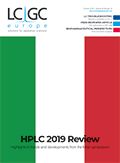
Separating Impurities from Oligonucleotides Using Supercritical Fluid Chromatography
February 21st 2025Supercritical fluid chromatography (SFC) has been optimized for the analysis of 5-, 10-, 15-, and 18-mer oligonucleotides (ONs) and evaluated for its effectiveness in separating impurities from ONs.

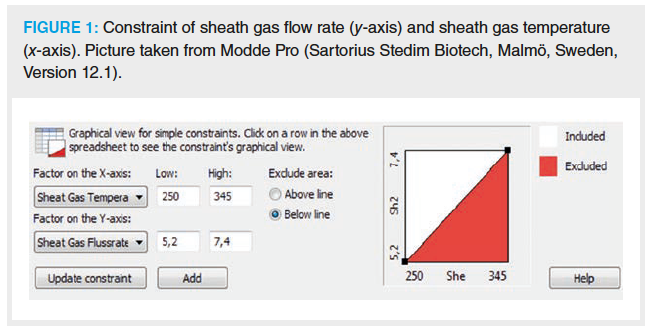


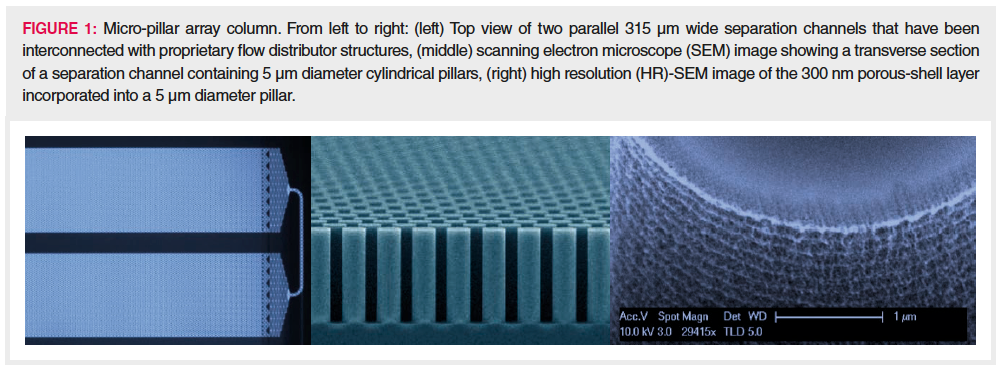


![LCE0918_Liu Bio[2]-1.jpg LCE0918_Liu Bio[2]-1.jpg](/_next/image?url=https%3A%2F%2Fcdn.sanity.io%2Fimages%2F0vv8moc6%2Fchroma%2Fbdc67a7da979cf6ba6cf989305aae36e6b3a9575-200x262.jpg%3Ffit%3Dcrop%26auto%3Dformat&w=3840&q=75)